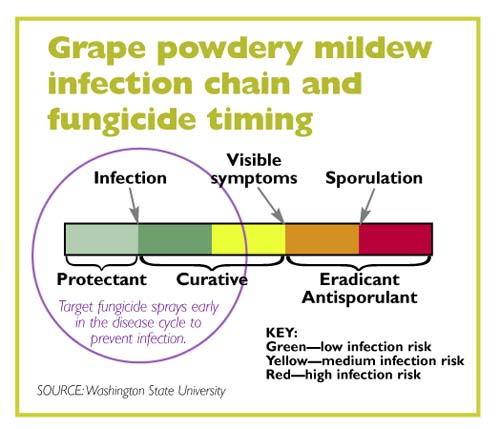Once you see a problem with powdery mildew in your vineyard, you’re already too late. Washington State University extension specialists want grape growers to focus on prevention, rather than wait for symptoms to trigger their action.
Most pest management programs use economic thresholds to guide action or spray decisions, but disease management programs typically don’t fit the economic threshold concept, says WSU’s Dr. Michelle Moyer, statewide viticulture extension specialist. The economic threshold, also called the treatment or action threshold, is a predetermined pest density/population level at which control is needed to prevent the pest from reaching an economic injury level.
“Thresholds are a concept of integrated pest management,” Moyer said during a statewide wine grape convention held in Kennewick, Washington, in February. “It’s a point where if you have x number of mites or leafhoppers, you must take action or you’ll see an economic loss. But thresholds don’t exist for powdery mildew or botrytis bunch rot because disease management is usually based on prevention and is not curative or reactionary.”
Some pathogens are monocyclic, meaning they develop through just one generation per year, and take a long time to build up in the vineyard. Crown gall and Eutypa dieback in grapes are examples of pathogens that growers can tolerate somewhat in the vineyard because the disease can take years to reach economic injury levels. But powdery mildew and botrytis are polycyclic, developing through multiple generations during the growing season.
“It’s the difference between simple interest banking being monocyclic and compound interest as polycyclic,” she said, adding that polycyclic diseases can multiply exponentially. “With polycyclic pathogens that build rapidly, you can’t tolerate an initial level. You have to focus on preventing the disease from showing up, because by the time you see it, it’s too late.”
Window of susceptibility
The grapevine follows a physiological calendar of development during the growing season. Within this calendar, there are times when the vine is more susceptible to powdery mildew. She cited research from Cornell University that shows grape clusters are most susceptible to powdery mildew from prebloom to about four weeks after fruit set. To determine this, Cornell scientists inoculated clusters with powdery mildew in the vineyard at various stages of development and measured disease incidence at harvest. Clusters inoculated at prebloom and when the fruit was BB-sized were completely rotted by harvest. However, the later the cluster was inoculated, the less disease there was at harvest.
By timing fungicide sprays when clusters are most susceptible to the disease, you can delay disease progression in the vineyard and help clusters escape infection, Moyer said. “If you delay enough the rate of increase and keep disease pressure low, then you can keep fruit from becoming infected.
“With powdery mildew, you don’t spray based on what you see, but on what you’re trying to prevent.”
Cornell researchers also found that as clusters transition to resistance, the berries that are nearly immune to infection may still support what are known as diffuse mildew colonies. Clusters with diffuse infection appear to the naked eye to be healthy and free of powdery mildew, but symptoms can be seen when examined under a microscope. “These necrotic spots or dead tissue can enhance botrytis later in the season,” Moyer said. “They’re perfect places for botrytis to set up shop.”
 Fungicide programs
Fungicide programs
WSU extension plant pathologist Dr. Gary Grove, who spoke at the same grape meeting, offered tips for developing an effective disease management program. Grove has spent years studying the efficacy of grape and tree fruit fungicides, calculating optimum spray timing, and developing resistance management strategies.
The bottom line in powdery mildew management is timing, he said. “The longer you wait in the infection process, the more inoculant you have on the leaf surface. By the time you can see powdery mildew on the leaves, the disease is already producing millions of spores.”
Grove advised growers to choose chemicals with protectant activity as they work to protect the grapevine from initial infection. Curative modes of action are used to cure the early infection stages; eradicants are last-ditch fungicides, and there are few effective ones.
He urged growers to target their disease management efforts at the early infection stage (see Figure 1). Those who don’t use a prevention strategy, risk affecting their grape quality at harvest and jeopardizing relationships with winemakers.
“You can fool some of the people some of the time, but you cannot fool the winemaker,” Grove said. “Take the period of fruit susceptibility
Growers must deal with both the fruit and foliar phases of powdery mildew. The fruit phase impacts the quality and marketability of the grapes. The foliar phase only affects the canopy, but sets the vineyard up for increased disease pressure the following season.
Spray early
Although postharvest or dormant sprays can help reduce primary spores, which are in the fungal overwintering structures called chasmothecia, he doesn’t advocate postharvest sprays. “The overwintering spores are usually formed before veraison, and finding an effective material to kill them is the problem.”
A better strategy, he said, is to start sprays earlier the next season, providing good coverage when shoots are about ten inches long and continuing sprays through fruit set.

Leave A Comment